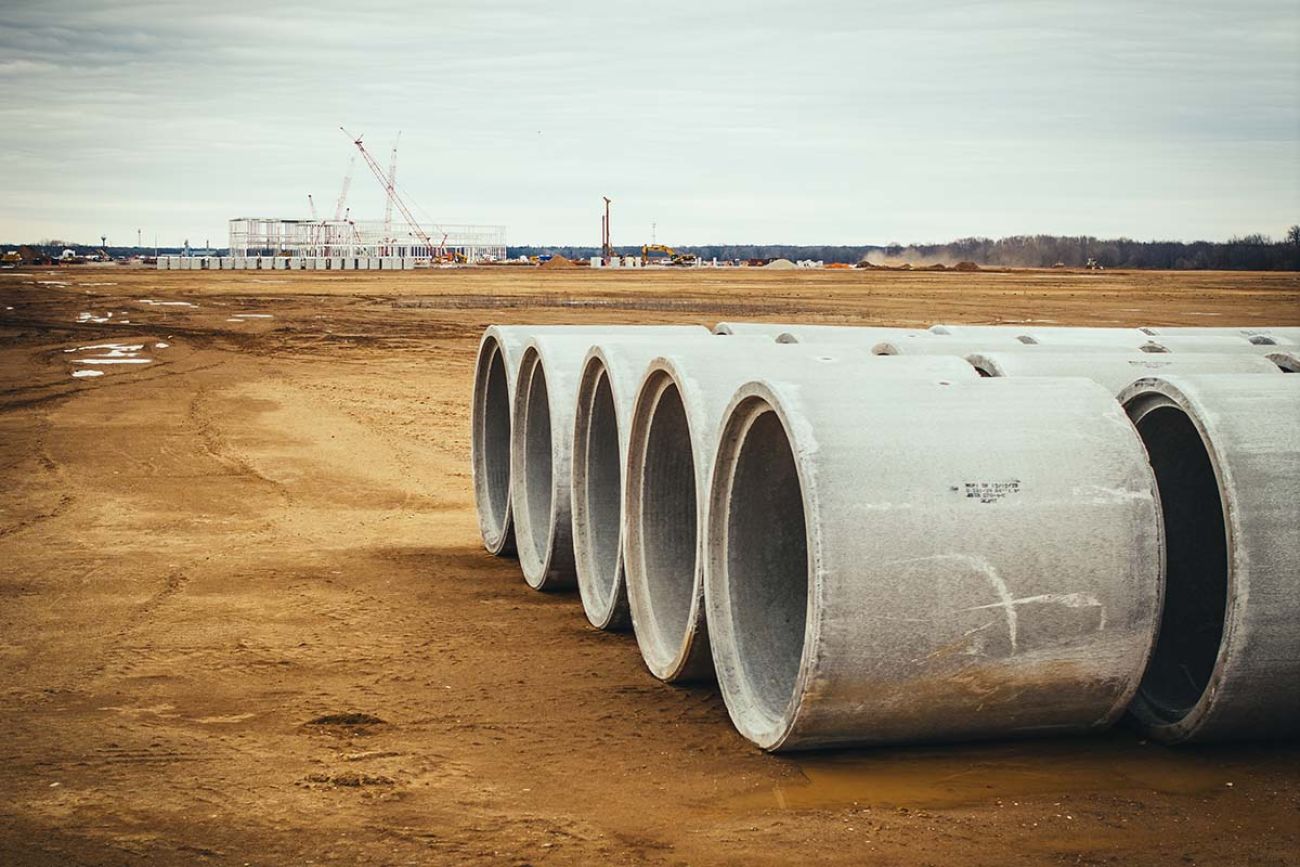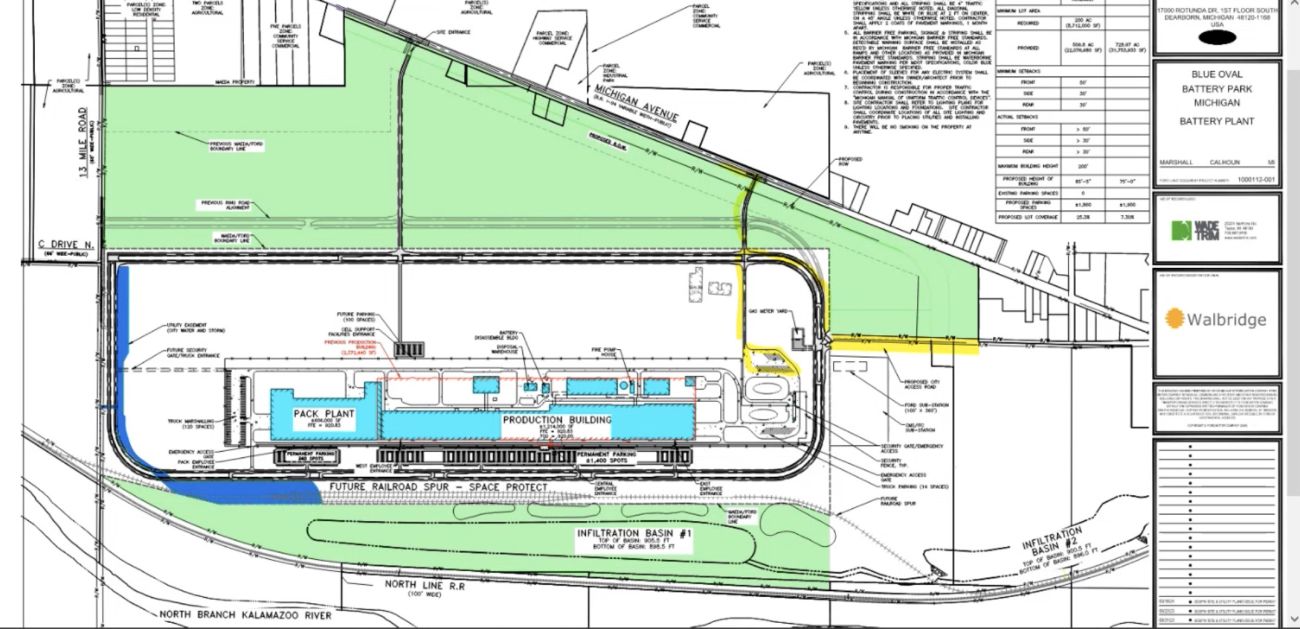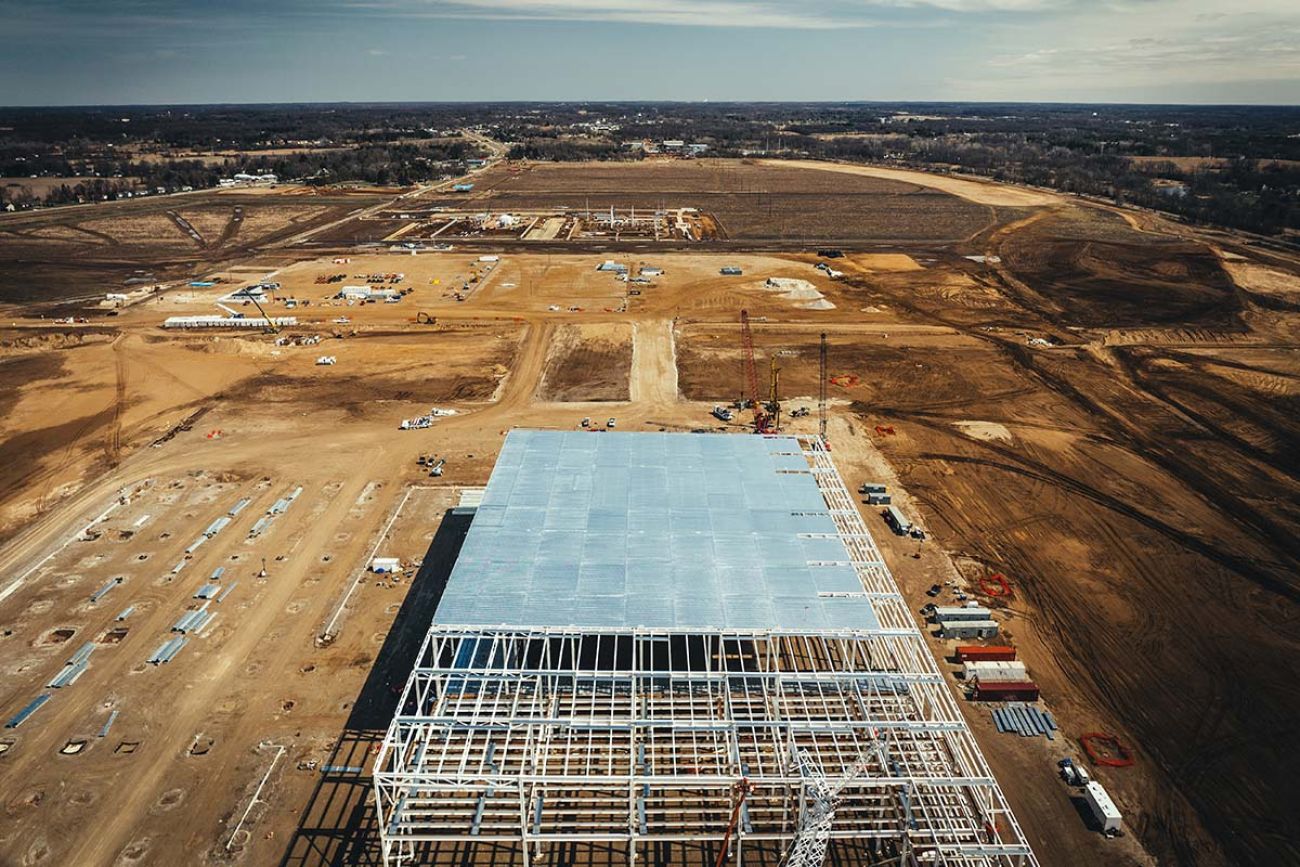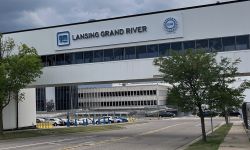Ford changes EV strategy but proceeds with smaller Michigan battery factory

- Construction is underway in Marshall, where Ford Motor Co. is building an EV battery factory
- The project — initially valued at $3.5 billion — was announced, suspended and then downsized all in 2023
- Michigan committed about $2 billion in incentives toward the project; so far, it’s undetermined if they will be reduced
MARSHALL — Ford Motor Co. is rapidly shifting its strategies to enable the Dearborn-based automaker to hold onto its market share in the roiling electric vehicle market.
Amid many recent changes — like pausing a new electric truck and a three-row SUV, plus turning to more hybrid models — Ford is standing firm in its plans to build a new EV battery factory in Michigan.
BlueOval Battery Park Michigan, based in Calhoun County’s Marshall, is under construction now. It is among the most expensive EV-related projects announced for the state.
Related:
- Stung by EV losses, Ford plans smaller Michigan factory with fewer jobs
- Ford EV battery plant on Marshall Michigan megasite gets $1B in incentives
- Judge denies bid to halt site work for Ford EV battery plant in Marshall
The original price tag was $3.5 billion before Ford said in late 2023 it would downshift its plans. The move was expected to trim at least $1 billion from the investment. At the same time, Michigan’s stake in the Marshall deal totals $2.2 billion in incentives.
The factory is under construction on the so-called megasite property in Marshall, about 2,000 acres now known as the Marshall Area Jobs, Opportunities, and Recreation Campus (MAJOR).
Here are the latest things to know about the Ford megasite development, following a recent site plan submitted to Marshall, and a public review last week by city officials and contractors:
Ford’s portion of the site is smaller.
The automaker’s footprint in Marshall is just over 500 acres, the site plan shows, compared to the 730 acres originally planned.

The 30% reduction in land area means that Ford now will occupy about 25% of the Marshall megasite, including land within its so-called ring road around the parcel.
Most of Ford’s building construction is in the lower half of its property.
Trimming the Ford portion means that the megasite developer, the Marshall Area Economic Development Alliance (MAEDA), retains control over the northern portion of the land, bordering Michigan Avenue. (The green area in the site plan.)
When Ford announced the project in February 2023, the new factory was expected to take over 950 acres, with a portion of that turned into a conservation easement on the Kalamazoo River.
The conservation parcel is between the railroad tracks at the southernmost portion of the Ford site and the Kalamazoo River. No changes have been made to the size of that property, city officials said.
Ford changed its building footprint — and will do so again
Ford originally expected to build a 2.3 million-square-foot production facility for lithium iron phosphate (LFP) batteries. (That battery chemistry is lower-cost than more common lithium-ion batteries, something Ford has said is critical to vehicle affordability — and to the company reaching its goal of 8% return on its EV portfolio.)
Today’s construction reflects a 1.2 million-square-foot production building, a reduction of nearly one-half.
However, Ford added a 600,000-square-foot packing plant to the west of the production building. The battery cells, once built next door, then will be assembled into a battery pack.
More construction is coming to the property just north of the production building. The first two buildings will be a battery disassembly building and a disposal warehouse. Plans for those have not been submitted to the city, but they are expected by late spring, consultants said last week.
Other “process buildings” for efficient battery building are under development, including a fire pump house.

Employment
The number of workers remains lower than the 2,500 originally forecast. By fall 2023, the number had dropped to 1,700 — a total that economic developers said still represents significant hiring for the site.
Ford also once expected to develop 1,900 parking places at Blue Oval Battery Park in Marshall, but the automaker has trimmed that to about 860 onsite at the new factory.
The number of new parking spaces will accommodate workers on multiple shifts, according to information at the recent site plan review.
Meanwhile, Ford has posted eight jobs for the Marshall factory. They include human resources director, IT director and area program manager.
Traffic plans in Marshall are already changing for Ford
The Marshall area is preparing for an increase in traffic due to the factory, both trucks and worker vehicles.
Traffic signals have been installed at Michigan Avenue and I-69 east of the megasite, and they’re scheduled to start operating by May.

Meanwhile, discussions among all of the planning groups and the Michigan Department of Transportation continue about how to configure roads in and out of the megasite.
While there are plans for turn lanes from Michigan Avenue to the center area of the area housing Ford, questions have been raised about trying to get trucks to bypass the I-94 exits and use the I-69 access to Michigan Avenue instead.
MDOT is finalizing a study, the planning group said last week. More details will be determined at future meetings, they added.
So far, there are no plans for bus service to the site, officials said in response to questions raised at the planning meeting. Setting up a plan for workers to bike to the factory is also being discussed, but no plan for bike paths or sidewalks on Michigan Avenue has been finalized.
Incentives
Michigan’s stake in the Marshall deal totals about $2 billion in incentives, including a local tax break worth about $772 million, $330 million for road upgrades, and a $210,000 job-creation grant that would go directly to Ford once it hires at the facility. The incentives include an initial state award in February, followed by multiple additions, including legislative actions.
Beyond that, nearly a half-million dollars have been awarded to MAEDA for its role in acquiring property for the megasite. Other tax breaks are expected by the time the factory opens.

The downshifting at the factory reduced Ford’s investment by about $1 billion. That, in turn, prompted the state to say it would reevaluate how much it will spend on the project.
"As Ford has had to make some changes … the state's role will change as well," Gov. Gretchen Whitmer said in November. "When one aspect gets resized, so does the other."
So far, there’s no conclusion to a reduction in incentives.
“Terms and conditions of the incentives to support Ford’s BlueOval investment will be adjusted and reduced appropriately once the final scope of the project is determined and communicated by Ford,” Otie McKinley, spokesperson for the MEDC, told Bridge this week. “At this time, project scope details are still being finalized by the company.”
Further, McKinley told Bridge, “Ford has not received any state support for this project.”
Protests continue against the development
Public backlash against the development continues, with protesters gathering twice weekly downtown and litigation continuing.
Some of the protesters raise questions about public processes of the developments.
The development, for example, is not being approved by the Marshall Planning Commission. Instead, Eric Zuzga, director of community services for the city, said the Ford development is on industrial property where zoning allows site plan approval by administrative review. The project still must meet city ordinances, he said.
Litigation by a group called Committee for Marshall — Not the Megasite seeks to force a referendum vote on the rezoning of the factory site.
The megasite was formed from land in both Marshall and Marshall Township, which enacted a land-sharing agreement to allow the large-scale development. The community group said that its petitions to seek a public vote on the rezoning were ignored. That case is now in the Michigan Court of Appeals.
Meanwhile, the factory will be a wholly owned subsidiary of Ford. The automaker is licensing battery technology from Contemporary Amperex Technology Co., Limited (CATL), a Chinese company that is the largest global EV battery maker.
Questions also persist about the role of CATL in Ford’s plans
The automaker has said that it is licensing CATL battery technology, which has driven the Chinese company to the top of global EV battery makers. Public and political concerns persist, prompted by the tense relations between the U.S. and China.
Business Watch
Covering the intersection of business and policy, and informing Michigan employers and workers on the long road back from coronavirus.
- About Business Watch
- Subscribe
- Share tips and questions with Bridge Business Editor Paula Gardner
Thanks to our Business Watch sponsors.
Support Bridge's nonprofit civic journalism. Donate today.
See what new members are saying about why they donated to Bridge Michigan:
- “In order for this information to be accurate and unbiased it must be underwritten by its readers, not by special interests.” - Larry S.
- “Not many other media sources report on the topics Bridge does.” - Susan B.
- “Your journalism is outstanding and rare these days.” - Mark S.
If you want to ensure the future of nonpartisan, nonprofit Michigan journalism, please become a member today. You, too, will be asked why you donated and maybe we'll feature your quote next time!




